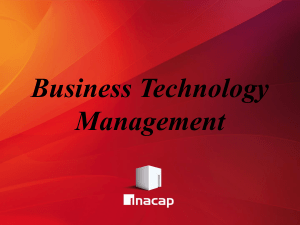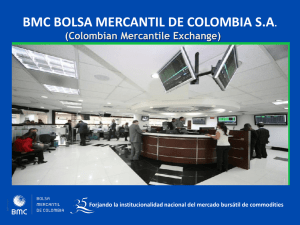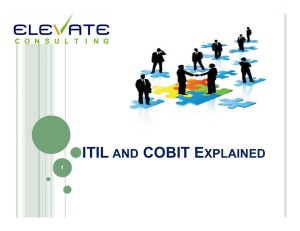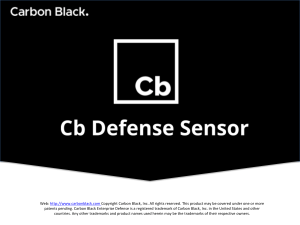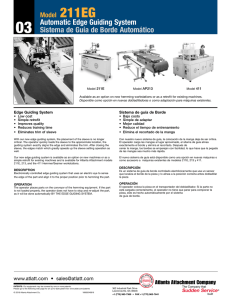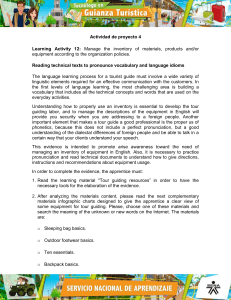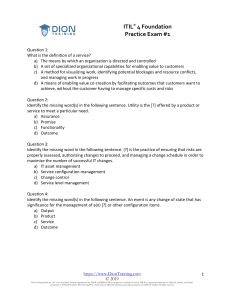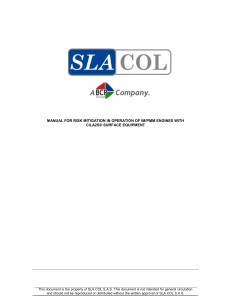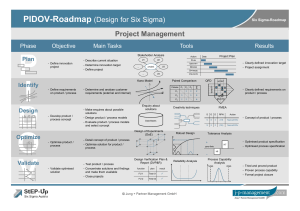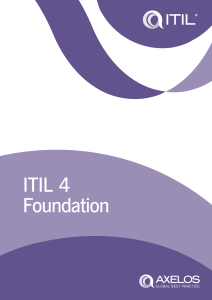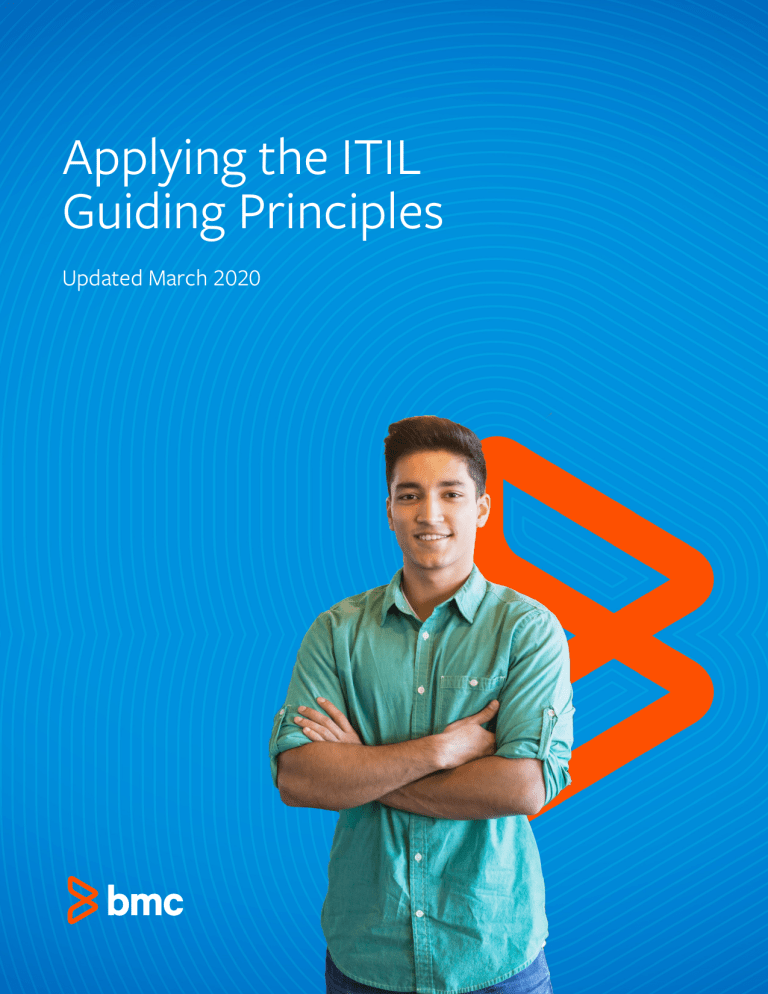
Applying the ITIL Guiding Principles Updated March 2020 1 This publication has been revised by Barclay Rae to bring the content up to date with current ITIL guidelines. Rae is an independent management consultant, analyst, and writer in the ITSM Industry, with over 20 years consultancy experience involving over 500 projects. He is a ITIL4 co-author and lead editor of the ITIL4 Create, Delivery and Support publication, co-author of the 2016 “ITIL Practitioner Programme,” plus a contributor to SDI standards and certification programs. Rae has over 30 years’ experience in IT and is also currently operating as the CEO of ITSMF UK. ITIL is a registered trade mark of AXELOS Limited. All rights reserved. ® ® Note to Readers This publication highlights the key elements of the ITIL Service Design publication and includes commentary on important concepts from BMC and ITIL experts. BMC Software, the BMC Software logos, and all other BMC Software product or service names are registered trademarks or trademarks of BMC Software Inc. All other registered trademarks belong to their respective companies. Copyright © 2020 BMC Software Inc. All rights reserved. 2 Introduction In early 2019 Axelos released the latest version of the global best practice for IT Service Management, ITIL 4. In the version of the framework Axelos has gathered subject matter experts from around the globe to ensure greater alignment and integration with modern day working practices, methodologies and standards, including DevOps, Agile and Lean approaches. ITIL 4 recognises the focus of modern IT organizations on digital transformation, customer experience and the drive for service excellence. The framework is designed to offer practical guidance to any organization looking to understand how to adopt and apply a best practice mindset and approach to their IT Service Management capabilities. and stable evolving through organic growth. The concepts and models defined can be used to deliver excellence and drive maturity in any approach to IT Service Management. ITIL 4 is a significant development from previous version, although much of the detailed ‘practice’ content remains in a recognisable form. The context and positioning of ITIL has however developed as a strategic and unifying element across the business and technology landscape. The approach has changed to ensure that ITIL meets the needs of a modern digital based service management workforce. ITIL 4 is specifically designed to address the needs of all verticals and levels of maturity, whether an organization be high velocity in nature, steady 3 Overview The development of ITIL4 has ‘opened up’ and broadened the scope approach to service management and ‘ITSM’. This has been achieved by clarifying that a flexible approach is the route to successful service delivery. Fixed processes and practices can never meet all business and user requirements, so the approach to service delivery must involve an understanding and application of contextual knowledge. Great service is delivered through shared goals, common understanding, customer and business focus, great communications and human empathy for delivering and receiving services – ‘co-creating value’. This does not happen with fixed and doctrinaire processes, ‘one-size-fits-all’ service targets, hierarchical and internally focused work practices. ITIL has never set out to create these sorts of implementations and the ITIL4 approach has been driven by a strong desire to ensure that this message is clearly stated, fully received and understood. That message is that success depends on an understanding of the outcomes and value of delivery activities, not just from focusing on the activities themselves. Good service management must focus on those contextual goals, not arbitrary ‘SLA’ targets, and great service can be achieved by building flexibility and business knowledge into processes. ITIl4 cannot be any clearer about the nature and success criteria of service delivery work – this is a constantly moving target that requires creative forces at work to deliver results, not a rigid set of constraints. It is of course not a simple task to move from a process-centric way of working to a more flexible approach. For the people involved in delivering IT knowledge-work, there can be real challenges in suddenly being told that they should use their own initiative, rather than blindly follow processes. What should they do? How flexible should they be? Can they simply do what they think is right or should they follow the rules as before? Organisational culture is a powerful force and change is a major challenge for many people as well as organisations. 4 The ITIl4 Guiding Principles provide the mechanism to give people guidance on how to use their initiative and also to 4focus on doing the right things for their organisation. Every organisation needs processes, to deliver consistent, sustainable and repeatable work. Restaurants require to have clear guidelines and processes on how to prepare and serve their dishes (their products). Without these there would be no consistent customer experience of the chef’s food, or also or how to deliver dishes effectively and profitably. Processes are a vital part of every service organisation’s DNA. However, dealing with an organisation that is only super-efficient at its own processes in not usually a great experience – unless you simply want the standard ‘vanilla’ output. A fast food restaurant is a good example here where the customer wants and expects the standard experience, perhaps at the expense of quality. The experience required and the intended outcome is actually to get decent, consistent food quickly rather than great cuisine at leisure. However, this does not work in a restaurant where there is a changing and wider menu, and where the customer’s service experience is a key factor. Some customers may want some variation on sauces or accompaniments to food, they will have preferences in terms of how the food is cooked and served – that is all part of what is being offered, not just a standard, ‘take it or leave it’ menu. In order to meet these requirements, the catering and serving staff have to be able to modify their tasks in preparing and delivering the food. Otherwise there will be a negative response, poor feedback and no repeat business. Similarly, other customer service environments must allow their people some flexibility and the ability to step outside of their standard processes where this is required. In many cases an 8-hour response to a simple request for IT help may be good enough. However, on some occasions, there is a much higher business imperative to get this resolved very quickly, and this is not simply determined by the type of product that is being supported. For example, fixing an issue with a user’s ability to access email on an employee’s mobile phone may not be a high priority issue – as they may be able to use email and MS-Outlook on their PC instead, or they are happy to wait a few hours. If however, that person needs to access a file with an updated presentation deck that they need to present to the world’s media in the next 10 minutes, this could have a huge impact on the company’s reputation and share value. Obviously in this case there would need to be an instant response and action, however in terms of how the ‘SLA’ is currently defined this might not be what is expected in the current process. SLAs that are solely based on products do not take into account the business and human context that these products may need to be used in. Flexibility is needed in understanding the business situation and the context that the person is working within. It would be senseless for a support person to simply work to follow the standard 8-hour SLA for desktop support in this case, yet this may still happen, to the detriment of all parties. 5 In addition, in the way that teams and organisations work, there needs to more of an understanding of where the work fits in, in terms of the ultimate aim and output, plus also how teams work together to achieve shared goals. Teams that work in isolation and without an understanding of the ‘bigger picture’ of what is being delivered will miss opportunities to improve and achieve success. If your team is solely focussed on doing its part only and not striving to improve how it deals with input and outputs from other teams, then the overall delivery may be impacted. Employees need to be given standard processes to work from – however they also need some additional criteria to help them make good decisions that by-pass these criteria – when it makes sense and delivers value. The ITIL4 guiding principles have been created to provide this set of criteria and guidance – to give permission for people to act flexibly, to ‘sense and respond’, to work more effectively together, and to do the right thing, in the right context. What are the Guiding Principles? The Guiding Principles (GPs) are set of simple axioms by which people and teams can work to achieve value, as a generic approach and regardless of the rules and processes that they are set within. Whilst processes are important and necessary, these should be approached within the context of the values set out in the GPs. The principles are • Focus on Value • Start where you are • Progress iteratively with feedback • Collaborate and promote visibility • Think and work holistically • Keep it simple and practical • Optimise and automate How have these been created? The 7 ITIl4 Guiding Principles have been developed from initial work set out in the ITIL Practitioner guidance (2015). The original format of this was for 9 principles which have been consolidated into 7 as part of the ITIL4 Foundation book and training programme. A key element in these developments was in the reference to Agile, Lean and DevOps concepts and ways of working. The ITIL Practitioner book was not a DevOps book per ser, however it contained a number of ideas and ways of working that strongly reflected the thinking and practices in these areas. 6 How can these be used to achieve value? The Guiding Principles (GPs) are universal and applicable in many different and varying circumstances. These can be used in almost any work and service environment, as a means to define and deliver, build and support services, practices, systems, processes, communications, systems and interactions. ITIL 4 Guiding Principles can be applied to the way an individual works, to how one or more teams works and work together, to the ways of working for enterprise organisations. One key factor in the development of ITIl4 is continuity and flexibility – Organisations can use the ITIl4 Guiding Principles with their existing operations, whether based on ITIL v 2, 3 or any other models. The GPS can be used as a fast and effective way to release more value from the way that an organisation works by simply using these as questions to drive improvement: Focus on value - Are we delivering value / what do we mean by value / what is value to our customers / how do we deliver value and demonstrate value? There should be clear goals and measures in place that reflect the intended value proposition and expected outputs of the work, not just the components of the work. If any of the work, processes and steps are not clearly delivering some form of value (service quality, customer experience, financial result, reputation, risk reduction), then why is it being done.? Start where you are - Where do we start / where are we now / what is the gap between where we are and where we need to be? Can we build a realistic picture of our current capability / what are our actual performance levels / what are our customers and stakeholders saying about our service? ITIL is rarely used in a ‘green field’ situation and understanding the current state is vital to build practical and contextual planning. There is no perfect ITIL way of working and it is vital to be clear on where we actually are now / we need to observe this directly rather than rely on traditional ‘reporting’ data / can we also take advantage of and leverage work that has been done to date and built on that? Progress iteratively with feedback - how do we work / do we work in small steps / do we check progress and feedback/ how do we gather feedback / what do we do with feedback / is this used to build more quality and value into what we do? Feedback can be a number of inputs and data – from customer responses and requirements, to people and team-based content. Moving in small steps, building on feedback, helps to build trust in relationships, adding quality in a cumulative and low-risk manner. Collaborate and promote visibility - how do we work / do we work together, based on shared goals / do we make our work visible to those who need to see it / is the work accessible and easy to use / is the work being socialised and seen and understood by those that can add value to it? 7 Modern approaches to collaboration and visualisation of work include Kanban, which is a way to move information out of constraints of systems and build simple visual and public representations of work in progress. This provides transparency and greater team accountability and also encourages more interactions from those who may not be directly involved but who may have some relevant input. to land messages and get the desired results from people / how do good communications work? Think and work holistically – what is our work contributing to / is it clear how we are collaborating with other teams to achieve success / where could we improve in our collaborations / what are the upstream and downstream dependencies between teams / how do these contribute to success or failure / where are the blocking points and how can we un-block them / what is the ‘big picture that we are working towards? In most cases this is best delivered with minimal although relevant information, rather than unnecessary detail for e.g. ‘completeness’. Better to achieve the result than produce a pretty document that isn’t used. The Guiding Principles make it clear that successful service management is about working in a joined up ‘end-to-end’ manner, based on business context. ITIL can be challenging, complex and complicated, as it requires various groups of people to work together in changing environments, as well as with extensive and complicated systems. It is not about producing fixed and weighty documentation and enforcing its implementation. Effective communications focusses on achieving the intended outcomes, i.e. in documenting a working brief or to set out a process, the goal is to meet the brief or have the process working effectively, not to e.g. produce beautiful documentation. Optimise and automate – How can we work more efficiently / where can we speed up and optimise what we do / how can we remove blockers using technology / where can we achieve savings in costs and improvements in quality? It is important to consider optimisation before jumping into automation – some processes may simply need to be tweaked rather than automated. Work that is simply automated may be flawed or contain steps that are not accounted for – automation will only speed up this dysfunction. In addition, it is useful to view automation as a form of improvement rather than as an end in itself. Keep it simple and practical – how can we be lean / what is the most effective way to manage our documentation / what is most likely to be effective 8 Applying the Guiding Principles – e.g. to building SLAs Service level agreements define the core activity and expectation for any service management work – combining the core business requirements to the internal processes required to meet them. The approach to these artefacts can be transformed with the ITIl4 Guiding Principles by clarifying the need to be inclusive, flexible, business-focussed and to keep documentation simple. Building an effective SLA using the Guiding Principles. In the example table below, we look at how to use the Guiding Principles in a practical way – through building a Service Level Agreement (SLA). This could also be used with e.g. existing ITIL v3 processes and ways of working. QUESTIONS / STEPS What is an SLA? What service does it represent? What will be the objective of building and monitoring the SLA? GUIDING PRINCIPLE(S) COMMENTS Focus on value Taxonomy and simple definitions are important to build understanding, consensus and to avoid issues. It’s vital to focus on the key value of an sla. Keep it simple This should also be something that can be simply explained to anyone involved in using or delivering the service referred to. Think and work holistically The ‘service’ (or value-stream) that is being discussed as part of any agreement should be clear as an end-to-end combination of processes, inputs and outputs, with a clear definition of the outcome. Focus on value The outcome should also where possible be clarified in terms of its value to stakeholders Focus on value Engaging with customers/users of the service will help to identify the key requirements and business needs expected. Keep it simple This can then be summarised and used as the simple clear highlevel goal for the service – e.g. the technology is used as a key element to… (examples) • Ensure payments can be made and received • Warehouses can send out appropriate order to stores to keep shelves stocked • Ambulances are dispatched to the correct addresses in time 9 QUESTIONS / STEPS Who do we need to engage to discuss this? GUIDING PRINCIPLE(S) Collaborate and promote visibility COMMENTS It is essential to engage with users and customers to discover what their expectations and business needs are – this must be a collaborative activity. What will the SLA look like? Start where you are Ideally this should include techniques such as ‘journey mapping’ to reflect the actual customer experience of using the service, not simply the provider’s processes. Its also useful to look at what work has already been done in this area to discover and engage with users. As a result all SLAs should reflect local and business needs – they should not be ‘standard’ templates, rather they should reflect the needs of the customer organisation. What is the current level of expectation and delivery? Start where you are A key element in developing SLAs is to directly review current levels of actual service delivery and customer experience. This helps to identify realistic expectations and target for all parties. What are the new or future levels of expectation and delivery? Focus on value From customer engagement and journey mapping, the provider can then build a relevant ‘value stream’ of activities, processes, resources and delivery expectations that are aimed at meeting the desired SLA/business requirement and required level of user experience. Think and work holistically Collaborate and promote visibility How do we manage the relationship and build consensus on the SLA? Collaborate and promote visibility Engagement and collaboration are ongoing activities. What feedback mechanisms can we use? Progress iteratively with feedback Feedback covers a number of areas – customer feedback, project feedback, employee feedback, performance reporting, businesslevel feedback, input to new products, incident management output, complaints. It is important to review all of these and use these to drive priorities and actions. Keep it simple Outputs should be simplified and rolled up where possible to clarify messages – not just large listings of comments and issues, but clear trends and analysis, supportive by data and simple narratives. Optimise and automate Delivery and collection of feedback mechanisms should be simplified at the point of use as much as possible – much of this can be automated Visualising work and making this available in public spaces is also highly valuable to build ‘buy-in’ and increase the reach of issues to use the potential of a wide group of participants. 10 QUESTIONS / STEPS What tools and automation can be used? GUIDING PRINCIPLE(S) Optimise and automate COMMENTS There are now a number of tools available that can be used to automate simple and complex service management activity – logging, classifying, routing, resolving, incidents, fulfilling and managing requests, tracking and escalating SLA expectations, monitoring and taking pre-emptive actions, capturing and comping information and reports, delivering real-time updates etc. The process of defining and managing expectations is an obvious opportunity to improve the way that work is delivered in line with expectations. How can we identify the success of the process? Focus on value Whilst many tracking and monitoring processes can deliver outputs, part of the success of any SLA lies in showing that the over-riding business and experience goals are met. This requires clarity of purpose and also the ability to compile and summarise key end-to-end outcomes – positively or not. Did the process delivery what is expected from the business and its users – yes or no? What is the value expected – was this achieved? 11 Conclusion Whilst ITIL4 contains a number of ‘new’ (or new to ITIL) artefacts and concepts, (service value System, value streams, 4 dimensions, ‘practices’), the Guiding Principles provide a very simple and practical opportunity to apply new and improved ways of working quickly. As such these principles can and should be applied to existing operations and teams – e.g. if they are using ITILv3 processes, or any other processes or approaches. The key is that the Guiding Principles clarify the need for flexible and context-based working, rather than a prescribed set of rules and axioms set in stone. ITIL is used applied in constantly changing working conditions and so it must also be used with appropriate flexibility. Using this approach and following the guidance contained within the principles will also help to develop more understanding and awareness of the ITIl4 approach – with more end-toend collaboration, understanding of the user experience and clarification of business goals and expectations. ITIL4 also provides a revised definition of ‘value’, which includes the concept of this being ‘cocreated’ – value is achieved when services are consumed, and that the appropriate value streams are activated. Focus on value – i.e. to be clear on what outcomes are expected from the service – is a key element, and the Guiding Principles highlight this. Service management is about outcomes not the activities themselves. Transparency, feedback, holistic and iterative working are also all key elements that are initially and simply defined within the Guiding Principles. Most of all it is important to understand that ITIl4 is shifting that focus from simply what we do in service management, to how we do it. So, flexibility and human and business focus are at the centre of this thinking and are clearly defined as being the critical elements for successful delivery. Focus on value and keep it simple must be the watchword for all ITSM Practitioners. Optimisation and automation can and should be implemented where possible. Seeing and thinking about the end-to-end approach across teams and from a ‘big picture viewpoint will help us to work together for mutual success. 12 ITIL 4 Definitions Service Management – A set of organizational capabilities for enabling value to customers in the form of services Service – A means of enabling value co-creation by facilitating outcomes that customers want to achieve, without customers having to manage specific costs and risk Outcome – A result for a stakeholder enabled by one or more activities Utility – The functionality offered by a product or service to meet a particular need This is more easily understood as considering “what the service does” Value – The perceived benefits, usefulness and importance of something Warranty – The assurance that a product or service will meet agreed requirements Product – A configuration of an organization’s resources designed to offer value to a customer This is more easily understood as considering “how the service performs” Organization – A person or a group of people that has its own functions with responsibilities, authorities and relationships to achieve its objectives Service Offering – A formal description of one or more services, designed to meet the needs of a target consumer group. A service offering may include goods, access to resources and service actions Customer – A person who defines requirements for services and takes responsibility for outcomes from service consumption User – A person who uses services Sponsor – A person who authorizes the budget for service consumption Stakeholder – A person with a (vested) interest in the service provision, this can include shareholders, executive, customers and users etc Output – The tangible or intangible delivery of an activity Service Relationship – A cooperation between a service provider and a service consumer. Service relationships include service provision, service consumption and service relationship management Service Consumer – A role performed by an organization in a service relationship to consume services Service Provider – A role performed by an organization in a service relationship to provide services to consumers 13 Service Relationship Management – Joint activities performed by a service provider and a service consumer to ensure continual value co-creation based on agreed available service offerings Output – A tangible or intangible delivery of an activity Outcome – A result for a stakeholder enabled by one or more outputs Cost – The amount of money spent on a specific activity or resource Risk – A possible event that could cause harm or loss or make it more difficult to achieve objectives. Risk can also be defined as uncertainty of outcome, and can be used in the context of measuring the probability of positive outcomes as well as negative outcomes About BMC From core to cloud to edge, BMC delivers the software and services that enable over 10,000 global customers, including 84% of the Forbes Global 100, to thrive in their ongoing evolution to an Autonomous Digital Enterprise. BMC – Run and Reinvent BMC, BMC Software, the BMC logo, and the BMC Software logo are the exclusive properties of BMC Software Inc., are registered or pending registration with the U.S. Patent and Trademark Office, and may be registered or pending registration in other countries. All other BMC trademarks, service marks, and logos may be registered or pending registration in the U.S. or in other countries. All other trademarks or registered trademarks are the property of their respective owners. © Copyright 2020 BMC Software, Inc. www.bmc.com *522201* 14
